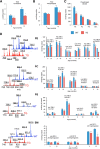Defects of Lipid Synthesis Are Linked to the Age-Dependent Demyelination Caused by Lamin B1 Overexpression
- PMID: 26311780
- PMCID: PMC4549407
- DOI: 10.1523/JNEUROSCI.1668-15.2015
Defects of Lipid Synthesis Are Linked to the Age-Dependent Demyelination Caused by Lamin B1 Overexpression
Abstract
Lamin B1 is a component of the nuclear lamina and plays a critical role in maintaining nuclear architecture, regulating gene expression and modulating chromatin positioning. We have previously shown that LMNB1 gene duplications cause autosomal dominant leukodystrophy (ADLD), a fatal adult onset demyelinating disease. The mechanisms by which increased LMNB1 levels cause ADLD are unclear. To address this, we used a transgenic mouse model where Lamin B1 overexpression is targeted to oligodendrocytes. These mice showed severe vacuolar degeneration of the spinal cord white matter together with marked astrogliosis, microglial infiltration, and secondary axonal damage. Oligodendrocytes in the transgenic mice revealed alterations in histone modifications favoring a transcriptionally repressed state. Chromatin changes were accompanied by reduced expression of genes involved in lipid synthesis pathways, many of which are known to play important roles in myelin regulation and are preferentially expressed in oligodendrocytes. Decreased lipogenic gene expression resulted in a significant reduction in multiple classes of lipids involved in myelin formation. Many of these gene expression changes and lipid alterations were observed even before the onset of the phenotype, suggesting a causal role. Our findings establish, for the first time, a link between LMNB1 and lipid synthesis in oligodendrocytes, and provide a mechanistic framework to explain the age dependence and white matter involvement of the disease phenotype. These results have implications for disease pathogenesis and may also shed light on the regulation of lipid synthesis pathways in myelin maintenance and turnover.
Significance statement: Autosomal dominant leukodystrophy (ADLD) is fatal neurological disorder caused by increased levels of the nuclear protein, Lamin B1. The disease is characterized by an age-dependent loss of myelin, the fatty sheath that covers nerve fibers. We have studied a mouse model where Lamin B1 level are increased in oligodendrocytes, the cell type that produces myelin in the CNS. We demonstrate that destruction of myelin in the spinal cord is responsible for the degenerative phenotype in our mouse model. We show that this degeneration is mediated by reduced expression of lipid synthesis genes and the subsequent reduction in myelin enriched lipids. These findings provide a mechanistic framework to explain the age dependence and tissue specificity of the ADLD disease phenotype.
Keywords: Lamin B1; chromatin; demyelination; gene expression; inflammation; lipid.
Copyright © 2015 the authors 0270-6474/15/3512003-16$15.00/0.
Figures










Similar articles
-
Autosomal Dominant Leukodystrophy: A Disease of the Nuclear Lamina.Front Cell Dev Biol. 2019 Mar 20;7:41. doi: 10.3389/fcell.2019.00041. eCollection 2019. Front Cell Dev Biol. 2019. PMID: 30949481 Free PMC article. Review.
-
Lamin B1 mediated demyelination: Linking Lamins, Lipids and Leukodystrophies.Nucleus. 2016 Nov;7(6):547-553. doi: 10.1080/19491034.2016.1260799. Nucleus. 2016. PMID: 27854160 Free PMC article. Review.
-
Lamin B1 mediates cell-autonomous neuropathology in a leukodystrophy mouse model.J Clin Invest. 2013 Jun;123(6):2719-29. doi: 10.1172/JCI66737. Epub 2013 May 15. J Clin Invest. 2013. PMID: 23676464 Free PMC article.
-
Mice overexpressing lamin B1 in oligodendrocytes recapitulate the age-dependent motor signs, but not the early autonomic cardiovascular dysfunction of autosomal-dominant leukodystrophy (ADLD).Exp Neurol. 2018 Mar;301(Pt A):1-12. doi: 10.1016/j.expneurol.2017.12.006. Epub 2017 Dec 17. Exp Neurol. 2018. PMID: 29262292 Free PMC article.
-
Cell signaling pathways in autosomal-dominant leukodystrophy (ADLD): the intriguing role of the astrocytes.Cell Mol Life Sci. 2021 Mar;78(6):2781-2795. doi: 10.1007/s00018-020-03661-1. Epub 2020 Oct 9. Cell Mol Life Sci. 2021. PMID: 33034697 Free PMC article.
Cited by
-
Conditioned Medium of BMSCs Alleviates H2O2-Induced Oxidative Damage in PC12 Cells Through the LDLR Pathway.Mol Neurobiol. 2025 Jul;62(7):8857-8867. doi: 10.1007/s12035-025-04804-w. Epub 2025 Mar 6. Mol Neurobiol. 2025. PMID: 40048057
-
The Goat (Capra hircus) Mammary Gland Mitochondrial Proteome: A Study on the Effect of Weight Loss Using Blue-Native PAGE and Two-Dimensional Gel Electrophoresis.PLoS One. 2016 Mar 31;11(3):e0151599. doi: 10.1371/journal.pone.0151599. eCollection 2016. PLoS One. 2016. PMID: 27031334 Free PMC article.
-
Impact of Nuclear Envelope Stress on Physiological and Pathological Processes in Central Nervous System.Neurochem Res. 2022 Sep;47(9):2478-2487. doi: 10.1007/s11064-022-03608-x. Epub 2022 Apr 29. Neurochem Res. 2022. PMID: 35486254 Review.
-
Autosomal Dominant Leukodystrophy: A Disease of the Nuclear Lamina.Front Cell Dev Biol. 2019 Mar 20;7:41. doi: 10.3389/fcell.2019.00041. eCollection 2019. Front Cell Dev Biol. 2019. PMID: 30949481 Free PMC article. Review.
-
Close Ties between the Nuclear Envelope and Mammalian Telomeres: Give Me Shelter.Genes (Basel). 2023 Mar 23;14(4):775. doi: 10.3390/genes14040775. Genes (Basel). 2023. PMID: 37107534 Free PMC article. Review.
References
-
- Bartoletti-Stella A, Gasparini L, Giacomini C, Corrado P, Terlizzi R, Giorgio E, Magini P, Seri M, Baruzzi A, Parchi P, Brusco A, Cortelli P, Capellari S. Messenger RNA processing is altered in autosomal dominant leukodystrophydagger. Hum Mol Genet. 2015;24:2746–2756. doi: 10.1093/hmg/ddv034. - DOI - PMC - PubMed
Publication types
MeSH terms
Substances
Grants and funding
LinkOut - more resources
Full Text Sources
Medical
Molecular Biology Databases
Research Materials
